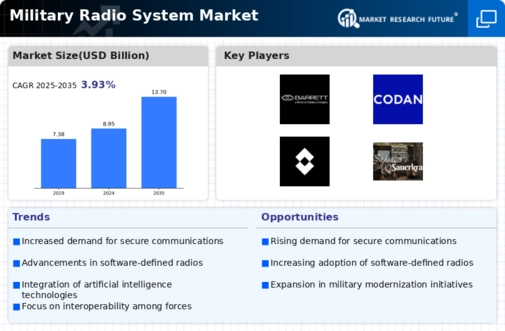-
Executive Summary
-
Market Attractiveness Analysis
- Global Military Radio System Market, by Type
- Global Military Radio System Market, by End User
- Global Military Radio System Market, by Region
-
Market Introduction
-
Market Definition
-
Scope of the Study
-
Market Structure
-
Key Buying Criteria
-
Market Factor Indicator Analysis
-
Research Methodology
-
Research Process
-
Primary Research
-
Secondary Research
-
Market Size Estimation
-
Forecast Model
-
List of Assumptions
-
Market Insights
-
Market Dynamics
-
Introduction
-
Drivers
-
Restraints
-
Opportunities
-
Challenges
-
Market/Technological Trends
-
Patent Trends
-
Regulatory Landscape/Standards
-
Market Factor Analysis
-
Value Chain/Supply Chain Analysis
- R&D
- Manufacturing
- Distribution & Sales
- Post-Sales Monitoring
-
Porter’s Five Forces Analysis
- Threat of New Entrants
- Bargaining Power of Buyers
- Threat of Substitutes
- Intensity of Rivalry
- Bargaining Power of Suppliers
-
Global Military Radio System Market, by Type
-
Introduction
-
Manpack Radios
- Market Estimates & Forecast, 2025-2034
- Market Estimates & Forecast, by Region, 2025-2034
-
Vehicular Radios
- Market Estimates & Forecast, 2025-2034
- Market Estimates & Forecast, by Region, 2025-2034
-
Global Military Radio System Market, by End User
-
Introduction
-
Naval
- Market Estimates & Forecast, 2025-2034
- Market Estimates & Forecast, by Region, 2025-2034
-
Ground Force
- Market Estimates & Forecast, 2025-2034
- Market Estimates & Forecast, by Region, 2025-2034
-
Air Force
- Market Estimates & Forecast, 2025-2034
- Market Estimates & Forecast, by Region, 2025-2034
-
Global Military Radio System Market, by Region
-
Introduction
-
North America
- Market Estimates & Forecast, by Country, 2025-2034
- Market Estimates & Forecast, by Type, 2025-2034
- Market Estimates & Forecast, by End User, 2025-2034
- US
- Canada
-
Europe
- Market Estimates & Forecast, by Country, 2025-2034
- Market Estimates & Forecast, by Type, 2025-2034
- Market Estimates & Forecast, by End User, 2025-2034
- UK
- Germany
- France
- Italy
- Rest of Europe
-
Asia-Pacific
- Market Estimates & Forecast, by Country, 2025-2034
- Market Estimates & Forecast, by Type, 2025-2034
- Market Estimates & Forecast, by End User, 2025-2034
- China
- Japan
- India
- Rest of Asia-Pacific
-
Middle East & Africa
- Market Estimates & Forecast, by Country, 2025-2034
- Market Estimates & Forecast, by Type, 2025-2034
- Market Estimates & Forecast, by End User, 2025-2034
- UAE
- Saudi Arabia
- Rest of the Middle East & Africa
-
Latin America
- Market Estimates & Forecast, by Country, 2025-2034
- Market Estimates & Forecast, by Type, 2025-2034
- Market Estimates & Forecast, by End User, 2025-2034
- Brazil
- Rest of Latin America
-
Competitive Landscape
-
Competitive Overview
-
Competitor Dashboard
-
Major Growth Strategies in the Global Military Radio System Market
-
Competitive Benchmarking
-
Market Share Analysis
-
Key Developments & Growth Strategies
- Product Launches/Service Deployments
- Mergers & Acquisitions
- Joint Ventures
-
Company Profiles
-
BARRETT Communications
- Company Overview
- Product Offering
- Financial Overview
- Key Developments
- Swot Analysis
- Key Strategies
-
Leonardo SpA
- Company Overview
- Product Offering
- Financial Overview
- Key Developments
- Swot Analysis
- Key Strategies
-
Harris Corporation
- Company Overview
- Product Offering
- Financial Overview
- Key Developments
- Swot Analysis
- Key Strategies
-
Radmor SA
- Company Overview
- Product Offering
- Financial Overview
- Key Developments
- Swot Analysis
- Key Strategies
-
Thales Communications & Security SAS
- Company Overview
- Product Offering
- Financial Overview
- Key Developments
- Swot Analysis
- Key Strategies
-
Codan Limited
- Company Overview
- Product Offering
- Financial Overview
- Key Developments
- Swot Analysis
- Key Strategies
-
Elbit Systems Ltd
- Company Overview
- Product Offering
- Financial Overview
- Key Developments
- Swot Analysis
- Key Strategies
-
FLIR Systems
- Company Overview
- Product Offering
- Financial Overview
- Key Developments
- Swot Analysis
- Key Strategies
-
Rockwell Collins, Inc.
- Company Overview
- Product Offering
- Financial Overview
- Key Developments
- Swot Analysis
- Key Strategies
-
Safran SA
- Company Overview
- Product Offering
- Financial Overview
- Key Developments
- Swot Analysis
- Key Strategies
-
Appendix
-
References
-
Related Reports
-
List of Abbreviations
-
Industry Insights
-
Note: This table of contents is tentative and subject to change as the research progresses.
-
List of Tables
-
Global Military Radio System Market, by Type, 2025-2034
-
Global Military Radio System Market, by End User, 2025-2034
-
Global Military Radio System Market, by Region, 2025-2034
-
North America: Military Radio System Market, by Country, 2025-2034
-
Europe: Military Radio System Market, by Country, 2025-2034
-
Asia-Pacific: Military Radio System Market, by Country, 2025-2034
-
Middle East & Africa: Military Radio System Market, by Country, 2025-2034
-
Latin America: Military Radio System Market, by Country, 2025-2034
-
North America: Military Radio System Market, by Country, 2025-2034
-
North America: Military Radio System Market, by Type, 2025-2034
-
North America: Military Radio System Market, by End User, 2025-2034
-
Europe: Military Radio System Market, by Country, 2025-2034
-
Europe: Military Radio System Market, by Type, 2025-2034
-
Europe: Military Radio System Market, by End User, 2025-2034
-
Asia-Pacific: Military Radio System Market, by Country, 2025-2034
-
Asia-Pacific: Military Radio System Market, by Type, 2025-2034
-
Asia-Pacific: Military Radio System Market, by End User, 2025-2034
-
Middle East & Africa: Military Radio System Market, by Country, 2025-2034
-
Middle East & Africa: Military Radio System Market, by Type, 2025-2034
-
Middle East & Africa: Military Radio System Market, by End User, 2025-2034
-
Latin America: Military Radio System Market, by Country, 2025-2034
-
Latin America: Military Radio System Market, by Type, 2025-2034
-
Latin America: Military Radio System Market, by End User, 2025-2034
-
List of Figures
-
Research Process of MRFR
-
Top-Down & Bottom-Up Approaches
-
Market Dynamics
-
Impact Analysis: Market Drivers
-
Impact Analysis: Market Restraints
-
Porter's Five Forces Analysis
-
Value Chain Analysis
-
Global Military Radio System Market Share, by Type, 2024 (%)
-
Global Military Radio System Market, by Type, 2025-2034 (USD Billion)
-
Global Military Radio System Market Share, by End User, 2024 (%)
-
Global Military Radio System Market, by End User, 2025-2034 (USD Billion)
-
Global Military Radio System Market Share (%), By Region, 2024
-
Global Military Radio System Market, by Region, 2025-2034 (USD Billion)
-
North America: Military Radio System Market Share (%), 2024
-
North America: Military Radio System Market, by Country, 2025-2034 (USD Billion)
-
Europe: Military Radio System Market Share (%), 2024
-
Europe: Military Radio System Market, by Country, 2025-2034 (USD Billion)
-
Asia-Pacific: Military Radio System Market Share (%), 2024
-
Asia-Pacific: Military Radio System Market, by Country, 2025-2034 (USD Billion)
-
Middle East & Africa Military Radio System Market Share (%), 2024
-
Middle East & Africa Military Radio System Market, by Region, 2025-2034 (USD Billion)
-
Latin America Military Radio System Market Share (%), 2024
-
Latin America Military Radio System Market, by Region, 2025-2034 (USD Billion)

















Leave a Comment